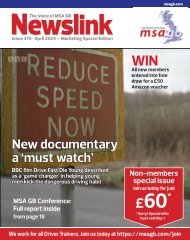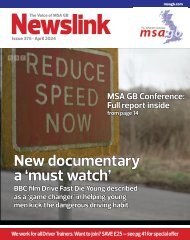Newslink December final
Motor Schools Association members magazine; driver training and testing; road safety
Motor Schools Association members magazine; driver training and testing; road safety
Create successful ePaper yourself
Turn your PDF publications into a flip-book with our unique Google optimized e-Paper software.
Towards your CPD: L-test data<br />
Steering a path through<br />
the TIP minefield<br />
Understanding the ADI Driving<br />
Test Data Report, which is<br />
available to all ADIs by clicking<br />
on the link at the end of this<br />
article, forms an essential part<br />
of our CPD, but only if what is<br />
being recorded is understood.<br />
Steve Garrod takes a closer look<br />
The first thing to say on your L-test data<br />
report is that like a lot of things in life, some<br />
headings are easier to interpret than others.<br />
For example, ‘Use of Mirrors’ before<br />
‘signalling’, ‘changing direction’ and ‘changing<br />
speed’ can be easier to understand than<br />
‘Steering’.<br />
It is important to point out, however, that it<br />
is making effective observation rather than<br />
looking at the mirrors that is marked, and<br />
changing speed means accelerating as well<br />
as slowing down. Changing direction is often<br />
marked when candidates are moving back to<br />
the left after passing a bus or a delivery van<br />
which is about to, or in the process of, moving<br />
off, as well as checking to the right before<br />
passing them.<br />
The reason for using ‘Steering’ as an<br />
example is because it was the subject that<br />
brought up more questions than any other<br />
heading at a recent Standards Check<br />
workshop. Steering can be quite difficult to<br />
interpret unless present at an end-of-test<br />
debrief. ‘Steering’ could mean not steering<br />
correctly at junctions, eg understeering or<br />
oversteering (not steering enough and<br />
maybe entering a side road on the wrong side<br />
of the road, or steering too much and having<br />
problems with straightening up having<br />
turned).<br />
But ‘steering’ can also be mixed up with<br />
‘Meeting Traffic’ or ‘Adequate clearance’. For<br />
example, if a candidate leaves it late to steer<br />
around a parked vehicle having given way to<br />
an oncoming vehicle, then this is marked as a<br />
steering fault. If you are conducting a mock<br />
test, then think about how you would debrief<br />
the fault. “You left it late to steer around the<br />
parked vehicle, causing you to steer onto the<br />
other side of the road due the lack of<br />
available space to turn’. When teaching we<br />
like to see our clients steer on a shallow angle<br />
past a parked vehicle wherever possible to<br />
reduce the amount of space needed on the<br />
opposite side of the road.<br />
Steering can also mean clipping or<br />
mounting the kerb or pavement when<br />
turning left or pulling up by the side of the<br />
road. From a teaching point of view, you could<br />
ask how to avoid this fault and the answer<br />
would normally be to steer later, when<br />
turning left, or straightening up earlier when<br />
pulling up next to the kerb.<br />
Interestingly, when pulling up, if the<br />
pavement is mounted but the fault is<br />
corrected and the car comes to rest with all<br />
four wheels on the road, then this is a<br />
steering fault, but if a wheel is left on the<br />
kerb, then this is marked as ‘Position for<br />
normal stops’<br />
Steering can also be marked when<br />
cornering – for example, if a driver is too<br />
close to a kerb or too near the centre of the<br />
road. It can be mistaken for road positioning,<br />
but if the position was correct upon entering<br />
the bend, then you need to ask yourself how<br />
the fault could be corrected. If a solid white<br />
line crossed or straddled, then a fault would<br />
be recorded under ‘Road markings.’<br />
Likewise, when turning right, if a driver<br />
goes past their point of turn, which is often<br />
caused by focusing on oncoming traffic and<br />
steering late, this is marked as a steering<br />
fault.<br />
Sometimes it can be tricky to assess a<br />
steering fault if a candidate approaches a<br />
junction too quickly. If it results in entering<br />
the side road on the wrong side of the road,<br />
then it could be marked as ‘steering’ as the<br />
effect of the fault was to steer onto the<br />
wrong side of the road, even though the<br />
cause of the fault was the speed on approach.<br />
18 NEWSLINK n DECEMBER 2023
















